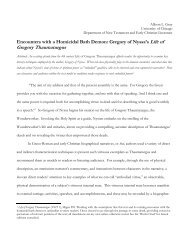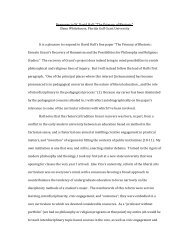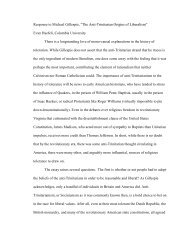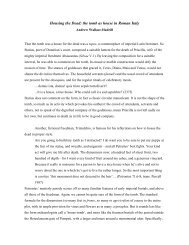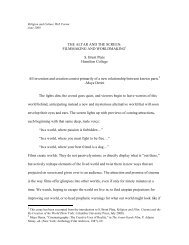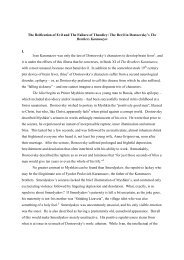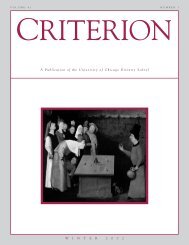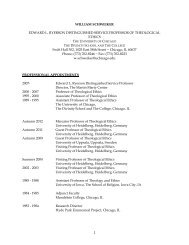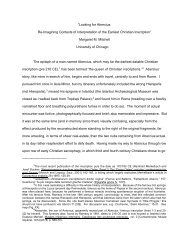Click here - Divinity School - University of Chicago
Click here - Divinity School - University of Chicago
Click here - Divinity School - University of Chicago
Create successful ePaper yourself
Turn your PDF publications into a flip-book with our unique Google optimized e-Paper software.
Veni, Creator Spiritus Nicolas de Grigny (1672–1703)<br />
Nicolas de Grigny, organist and composer, was born into a family<br />
<strong>of</strong> musicians and organists in Reims, north eastern France. He was<br />
appointed titular organist <strong>of</strong> Notre-Dame de Reims, the city’s famous<br />
cathedral in which French kings were crowned, in his early twenties.<br />
With François Couperin, he stands at the apex <strong>of</strong> the French classical<br />
organ tradition, though he had compiled but one single collection<br />
<strong>of</strong> compositions before his untimely death at the age <strong>of</strong> 31. Johann<br />
Sebastian Bach is known to have copied by hand all <strong>of</strong> de Grigny’s<br />
works, and we can surmise their being played on north German<br />
Baroque organs.<br />
This piece and the two that follow in this set are each based upon<br />
chants that would have been familiar to audiences <strong>of</strong> the day. Veni,<br />
Creator Spiritus falls into three short versets, <strong>of</strong> which the first will be<br />
played today. It presents the full plenum (full organ) sound <strong>of</strong> the<br />
Reneker Organ’s principal chorus, from 16 foot pipes up through the<br />
high mixtures, arrayed against the solo reed melody in the pedal.<br />
Alleluia, O quam suavis est Pierre Camonin (1903–2003)<br />
Pierre Camonin’s composition represents a twentieth century<br />
version <strong>of</strong> the improvisation on a chant melody heard in de Grigny’s<br />
piece. A student <strong>of</strong> Louis Vierne and Marcel Dupré at the Paris<br />
Conservatory, Camonin followed the example <strong>of</strong> the great French<br />
organists <strong>of</strong> the nineteenth and twentieth centuries, remaining in his<br />
post as organist at Notre-Dame de Verdun for 68 years, until his death<br />
at the age <strong>of</strong> 100. Ordained a priest in 1929, most <strong>of</strong> his composition<br />
is liturgical in nature, as is today’s selection, written for the feast <strong>of</strong><br />
Corpus Christi. This piece showcases beautiful flute stops <strong>of</strong> the<br />
Reneker Organ, used in ensemble texture and also in accompaniment<br />
to the lighter solo mutations and reeds.<br />
Pange lingua gloriosi Marc-Antoine Charpentier (1643–1704)<br />
Marc-Antoine Charpentier was the most important French composer<br />
<strong>of</strong> his generation. Employed by royalty, including the cousin and<br />
Dauphin-son <strong>of</strong> Louis XIV, he produced works for private royal chapels<br />
as well as court events such as the annual Corpus Christi procession.<br />
For twelve years Charpentier served as maître de musique to the Jesuits,<br />
and in his sacred tragedies written for the Jesuit community in Paris,<br />
he established the oratorio in France. From 1698 until his death,<br />
he was master <strong>of</strong> music at the Sainte Chapelle in Paris, a chapel to<br />
which Bond Chapel is <strong>of</strong>ten compared on account <strong>of</strong> its “walls” <strong>of</strong><br />
beautiful stained glass and its intimate size. Like the de Grigny piece,<br />
Charpentier’s exposition <strong>of</strong> the chant Pange lingua gloriosi features<br />
the full plenum <strong>of</strong> the organ, contrasted with typical Baroque French<br />
choruses <strong>of</strong> cromones and cornets.<br />
Ombra mai fu George Frideric Handel (1685–1759)<br />
With this selection and the next, we experience the combination<br />
<strong>of</strong> voice accompanied by Baroque organ, a sound which served to<br />
entertain gatherings <strong>of</strong> many kinds during the seventeenth and<br />
eighteenth centuries. Ombra mai fu is the opening aria from the<br />
1738 opera Xerxes by George Frideric Handel. It is sung by the main<br />
character, Xerxes 1 <strong>of</strong> Persia, admiring the shade <strong>of</strong> a plane tree.<br />
Frondi tenere e belle<br />
del mio platano amato<br />
per voi risplenda il fato.<br />
Tuoni, lampi, e procelle<br />
non v’oltraggino mai la cara pace,<br />
nè giunga a pr<strong>of</strong>anarvi<br />
austro rapace.<br />
Ombra mai fu<br />
di vegetabile,<br />
cara ed amabile,<br />
soave più.<br />
Tender and beautiful fronds<br />
<strong>of</strong> my beloved plane tree,<br />
let Fate smile upon you.<br />
May thunder, lightning, and storms<br />
never bother your dear peace,<br />
nor may you by blowing winds<br />
be pr<strong>of</strong>aned.<br />
A shade t<strong>here</strong> never was,<br />
<strong>of</strong> any plant,<br />
dearer and more lovely,<br />
or more sweet.<br />
The famous tune has <strong>of</strong>ten been arranged for other voice types and<br />
instruments, including solo organ, solo piano, violin and piano,<br />
and string ensembles, <strong>of</strong>ten under the title Largo from Xerxes. On<br />
December 24, 1906, a Canadian inventor and radio pioneer, Reginald<br />
Fessenden, broadcast the first AM radio program, which started with a<br />
phonograph recording <strong>of</strong> Ombra mai fu, thus apparently making this<br />
aria the first piece <strong>of</strong> music ever to have been broadcast on radio.<br />
BOND CHAPEL 13 THE U N I VER S ITY OF CHICAGO



